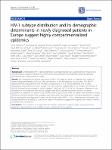HIV-1 subtype distribution and its demographic determinants in newly diagnosed patients in Europe suggest highly compartmentalized epidemics
Abecasis, Ana B.
Wensing, Annemarie M. J.
Paraskevis, Dimitris
Vercauteren, Jurgen
Theys, Kristof
Vijver, David A. M. C. van de
Albert, Jan
Asjö, Birgitta
Balotta, Claudia
Beshkov, Danail
Camacho, Ricardo J.
Clotet, Bonaventura
Gascun, Cillian De
Griskevicius, Algis
Grossman, Zehava
Hamouda, Osamah
Horban, Andrzej
Kolupajeva, Tatjana
Korn, Klaus
Kostrikis, Leon G.
Kücherer, Claudia
Background: Understanding HIV-1 subtype distribution and epidemiology can assist preventive measures and clinical decisions. Sequence variation may affect antiviral drug resistance development, disease progression, evolutionary rates and transmission routes. Results: We investigated the subtype distribution of HIV-1 in Europe and Israel in a representative sample of patients diagnosed between 2002 and 2005 and related it to the demographic data available. 2793 PRO-RT sequences were subtyped either with the REGA Subtyping tool or by a manual procedure that included phylogenetic tree and recombination analysis. The most prevalent subtypes/CRFs in our dataset were subtype B (66.1%), followed by sub-subtype A1 (6.9%), subtype C (6.8%) and CRF02_AG (4.7%). Substantial differences in the proportion of new diagnoses with distinct subtypes were found between European countries: the lowest proportion of subtype B was found in Israel (27.9%) and Portugal (39.2%), while the highest was observed in Poland (96.2%) and Slovenia (93.6%). Other subtypes were significantly more diagnosed in immigrant populations. Subtype B was significantly more diagnosed in men than in women and in MSM > IDUs > heterosexuals. Furthermore, the subtype distribution according to continent of origin of the patients suggests they acquired their infection there or in Europe from compatriots. Conclusions: The association of subtype with demographic parameters suggests highly compartmentalized epidemics, determined by social and behavioural characteristics of the patients.
Dateien zu dieser Publikation
Keine Lizenzangabe

